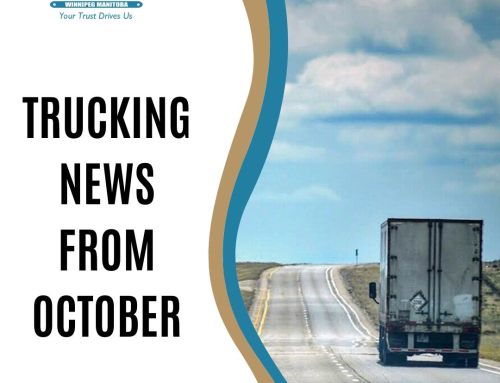 Truckering Winter Driving
Truckering Winter Driving
For professional truck drivers, the first hint of frost is a call to action. Canadian winters – from the Prairies to the mountain passes of British Columbia – present a unique and formidable challenge that tests both the power of your rig and the skill of the person behind the wheel. While the beautiful, snow-covered landscape can be breathtaking, it also hides hazards like black ice, whiteout conditions, and unexpected closures that demand respect.
At Len Dubois Trucking, safety isn’t just a policy; it’s our priority, especially when the temperatures drop. This comprehensive guide is designed to be your definitive resource for navigating the cold season safely and efficiently. We will cover the three pillars of winter safety: preparing your equipment, planning your route with real-time data, and mastering defensive driving techniques. By prioritizing preparation and utilizing every tool at your disposal, you can minimize risk, avoid unnecessary delays, and ensure you return home safely after every haul.
Pre-Trip Preparation – Winterizing Your Rig
A well-maintained semi-truck is your best defense against winter’s toughest conditions. Your pre-trip inspection is critical and must be thorough and tailored for the cold weather ahead. Taking the time to properly winterize your truck can prevent costly delays and dangerous breakdowns.
Tires and Chains: The Foundation of Traction
Inspect all tires, including spares, for proper tread depth and pressure. Traction is paramount in snow and ice, so ensure your tires are in top condition with no unusual wear. Additionally, be sure to carry snow chains if required by law in certain provinces, such as British Columbia. Crucially, practice installing them in a safe, dry spot before the snow hits so you are ready when required to chain up in adverse conditions.
Brake System Check and Moisture Control
Ice and moisture are the enemies of air brakes. Before every trip, ensure your air brakes are functioning optimally. A critical maintenance step is to regularly drain your air tanks to avoid moisture freezing within the system, which can severely compromise performance or lead to lock-ups. This simple habit can save you from a major incident.
Fluid Levels and Anti-Gel Measures
Protect your engine and systems by using winter-grade fluids, such as engine oil, coolant, and windshield washer fluid rated for extreme cold. Furthermore, be proactive with your fuel. Ensure your diesel includes anti-gel additives to prevent gelling or freezing in your lines and tanks, which is a common and frustrating cause of engine shutdown in deep winter.
Emergency Stockpile and Visibility Tools
Stock your cab with essentials for any roadside emergency. This includes reflective triangles, a fire extinguisher, warm clothing (layers are best!), non-perishable food, water, and a charged phone or portable charger. Before departing, equip your rig with a sturdy snow shovel, ice scraper, and brush to keep all windows, mirrors, and lights completely clear – visibility is non-negotiable.
Plan Ahead and Stay Informed
In winter trucking, your trip doesn’t start when you turn the key; it starts with careful planning. Real-time information about weather and road conditions is your most valuable asset, allowing you to make safe, informed decisions, especially regarding delays and closures.
Proactive Route Coordination
Never leave the yard without checking the latest weather forecast for your entire route. Winter weather can change rapidly, and a clear sky at your origin can quickly turn into a whiteout further down the line. Always coordinate with your dispatcher. They rely on real-time data and can provide critical insight on road closures, detour options, and safe truck stops or rest areas if you need to pull over.
Essential Real-Time Road Condition Resources
Accessing the official provincial road report systems is non-negotiable. These resources provide up-to-the-minute details on highway cameras, major incidents, closures, and the status of snow-clearing operations.
Here are the official resources for key provinces:
- British Columbia: DriveBC
- Alberta: 511 Alberta
- Saskatchewan: Highway Hotline
- Manitoba: Manitoba 511
- Ontario: Ontario 511
Winter Road Conditions Websites: Your Ultimate Survival Guide
Understanding Weather Alerts
Pay close attention to severe weather warnings issued by Environment Canada. Know the difference between a watch and a warning:
- Watch: Conditions are favourable for a severe event (e.g., heavy snowfall or freezing rain) to occur. This is your cue to begin preparations.
- Warning: A severe weather event is occurring or is imminent. This is a critical advisory; you should seriously consider delaying your trip or finding the nearest safe place to stop until conditions improve.
Check Road Bans and Weight Restrictions
Remember that certain rural highways and secondary roads may have seasonal weight restrictions or road bans put in place during the spring thaw or in periods of extreme cold. Always verify your Gross Vehicle Weight (GVW) against any posted restrictions for your planned route to avoid fines and potential damage to the roadway.
Practice Defensive Winter Driving
Handling a semi-truck on icy or snow-covered roads requires a heightened level of caution and skill. The rules change when the road turns white. Even the most powerful truck is vulnerable to the laws of physics when traction is compromised.
Reduce Speed and Increase Following Distance
This is the single most important rule. You must always drive below the posted speed limit and adjust your velocity based on visibility, road conditions, and the amount of traction you are feeling. Speed is the number one contributing factor in winter accidents. Maintain a massive gap behind other vehicles – experts recommend increasing your standard following distance (the four-second rule) to ten seconds or more. This provides the necessary buffer, as a truck’s braking distance can increase by up to ten times on ice.
Anticipate Problems and Avoid Black Ice
Always scan far ahead for potential hazards like slow-moving vehicles, snowplows, or obstructions. Be especially wary of black ice . This nearly invisible layer of ice forms first on bridges, overpasses, and shaded sections of the road because cold air circulates both above and below these structures. A key warning sign is when the spray from other vehicles’ tires suddenly stops – the road surface has likely frozen.
Slow, Deliberate Inputs Only
Sudden movements are the fastest way to lose traction and induce a skid. When driving in winter conditions, every maneuver must be gentle:
- Braking: Begin braking much earlier and apply the pedal slowly and lightly.
- Steering: Make slow, deliberate adjustments to the steering wheel.
- Acceleration: Use the throttle gradually to prevent wheel spin.
Use Engine Braking Wisely
While engine braking (or “jake braking”) is a valuable tool for slowing a truck, it should be used with extreme caution on slippery roads. Activating the engine brake suddenly can cause the drive wheels to lose traction, potentially leading to a jackknife. On icy roads, it is generally safer to avoid using the engine brake entirely and rely on light, gradual pressure to your foot brake.
Stay Prepared for Emergencies
Even the best-prepared drivers and most carefully maintained rigs can encounter unavoidable issues. Emergencies can happen suddenly in winter, but knowing how to respond calmly can make all the difference to your safety.
The Procedure for Being Snowed In or Stranded
If heavy snow or an accident leaves you stranded, the golden rule is: stay with your rig. Your truck provides the best protection, visibility, and supplies. If you cannot reach a safe pull-off point, pull as far off the road as possible. Use reflective triangles and hazard lights to ensure you remain visible, especially in low visibility. Only run the engine periodically (about 10 minutes per hour) to conserve fuel and keep the cab warm, and always ensure the exhaust pipe is clear of snow to prevent carbon monoxide buildup.
Managing Breakdowns
If a mechanical failure forces you to stop, contact roadside assistance or your dispatcher immediately. While waiting, keep warm by utilizing your emergency gear. It is safer to remain in your cab than to attempt to walk for help in freezing conditions or low visibility. When stepping outside, maintain three points of contact on your rig to prevent dangerous slips on icy steps.
When to Pull Over for Visibility
Do not attempt to push through a sudden whiteout or extreme fog. If heavy snow or fog impairs visibility to the point where you cannot clearly see the roadside or the vehicle in front of you, your safest option is to pull off the highway. Seek a safe location like a truck stop, rest area, or designated pull-off and wait for conditions to improve. No load is worth risking your life, the truck, or the safety of others.
Prioritize Your Health and Well-being
Long hours, stress, and challenging winter conditions can take a severe toll on professional drivers. Prioritizing your health ensures you remain alert, capable, and responsive – qualities that are absolutely critical when driving a heavy rig on slippery roads. Your well-being is a core component of safety.
Rest Well to Fight Fatigue
Fatigue severely impairs judgment, especially in difficult driving conditions where reaction time is paramount. Adhere strictly to Hours of Service regulations, and never attempt to push through fatigue. If you feel drowsy, the only solution is to pull over at a safe location, take a break, and rest. Recognizing the signs of fatigue and taking breaks when needed is a key professional responsibility in winter.
Stay Warm and Safe Outside the Cab
Ensure you wear appropriate clothing whenever you leave the warmth of your cab for pre-trip inspections, fueling, or chain-up procedures. Wear insulated, non-restrictive clothing and sturdy, waterproof boots with good traction. Staying warm helps you stay focused and prevents the hurried mistakes that can happen when your hands and feet are numb. When entering or exiting your truck, always use three points of contact to prevent dangerous slips and falls on icy steps or ground.
Eat and Hydrate Wisely
Your body needs fuel to stay alert. Carry high-energy, non-perishable snacks (like nuts, granola bars, and dried fruit) and plenty of water. Proper nutrition and hydration are vital to keeping your energy levels steady and your mind sharp during long winter hauls. Avoid excessive caffeine and sugary drinks, as they lead to energy crashes.
Final Reminders
Driving through a Canadian winter is a true test of professional skill, demanding intense vigilance and respect for the road. By diligently following these steps—from preparing your equipment and utilizing real-time provincial highway reports to practicing patient, defensive driving—you are taking control of your safety. Remember, the safest decision in winter is always the one that prevents an incident.
Small, Yet Important Tips for Winter Driving
- Clear the Entire Rig: Clear your entire rig (including the roof) of snow and ice before departure. Snow flying off your trailer is a danger to other motorists.
- Beware of Bridges and Overpasses: Be extra wary of overpasses and bridges, as they freeze faster and remain icy longer than regular pavement. Reduce speed significantly when approaching them.
- Carry Traction Aid: Always carry a bag of sand or salt to help with traction if you get stuck on a slick surface or incline.
- Wear Sunglasses: Use sunglasses or snow goggles to reduce the blinding glare from the sun reflecting off vast fields of snow.
- Top Up Fuel: Keep your fuel tanks topped up, not only to prevent fuel line freezing but also for the extra weight over the drive tires, which aids in traction.
The team at Len Dubois Trucking is committed to your safety this season. Drive smart, stay warm, and we look forward to seeing you return safely after every run.
Further Reading:
For more detailed insights into common driving errors in the cold, read our article: Top 8 Causes of Winter Accidents.




